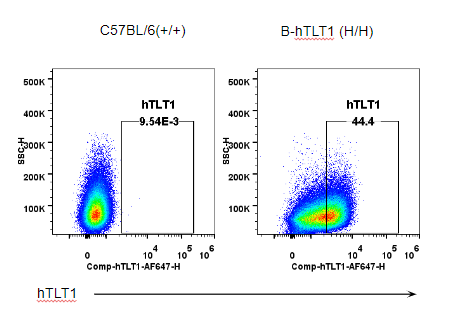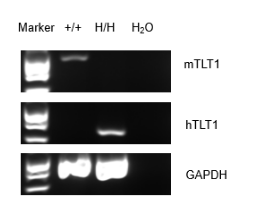Basic Information
-
Targeting strategy

-
Gene targeting strategy for B-hTLT1 mice.
The exons 1~4 of mouse Tlt1 gene that encode the extracellular domain were replaced by human TLT1 exons 1~4 in B-hTLT1 mice. -
Protein expression analysis

-

Strain specific TLT1 expression analysis in homozygous B-hTLT1 mice by flow cytometry. Blood platelet was collected from wild-type mice (+/+) and homozygous B-hTLT1 mice (H/H), and analyzed by flow cytometry with species-specific anti-TLT1 antibody. Human TLT1 was only detectable in homozygous B-hTLT1 mice.
-
mRNA expression analysis

-

Strain specific analysis of TLT1 mRNA expression in wild-type C57BL/6 mice and B-hTLT1 mice by RT-PCR. Spleen RNA were isolated from wild-type C57BL/6 mice (+/+) and homozygous B-hTLT1 mice (H/H), then cDNA libraries were synthesized by reverse transcription, followed by PCR with mouse or human TLT1 primers. Mouse Tlt1 mRNA was detectable only in wild-type C57BL/6 mice. Human TLT1 mRNA was detectable only in homozygous B-hTLT1 mice but not in wild-type mice.
-
Summary

-
mRNA expression analysis:
Mouse Tlt1 mRNA was detectable only in wild-type C57BL/6 mice. Human TLT1 mRNA was detectable only in homozygous B-hTLT1 mice but not in wild-type mice.Protein expression analysis:
Human TLT1 was only detectable in homozygous B-hTLT1 mice.


